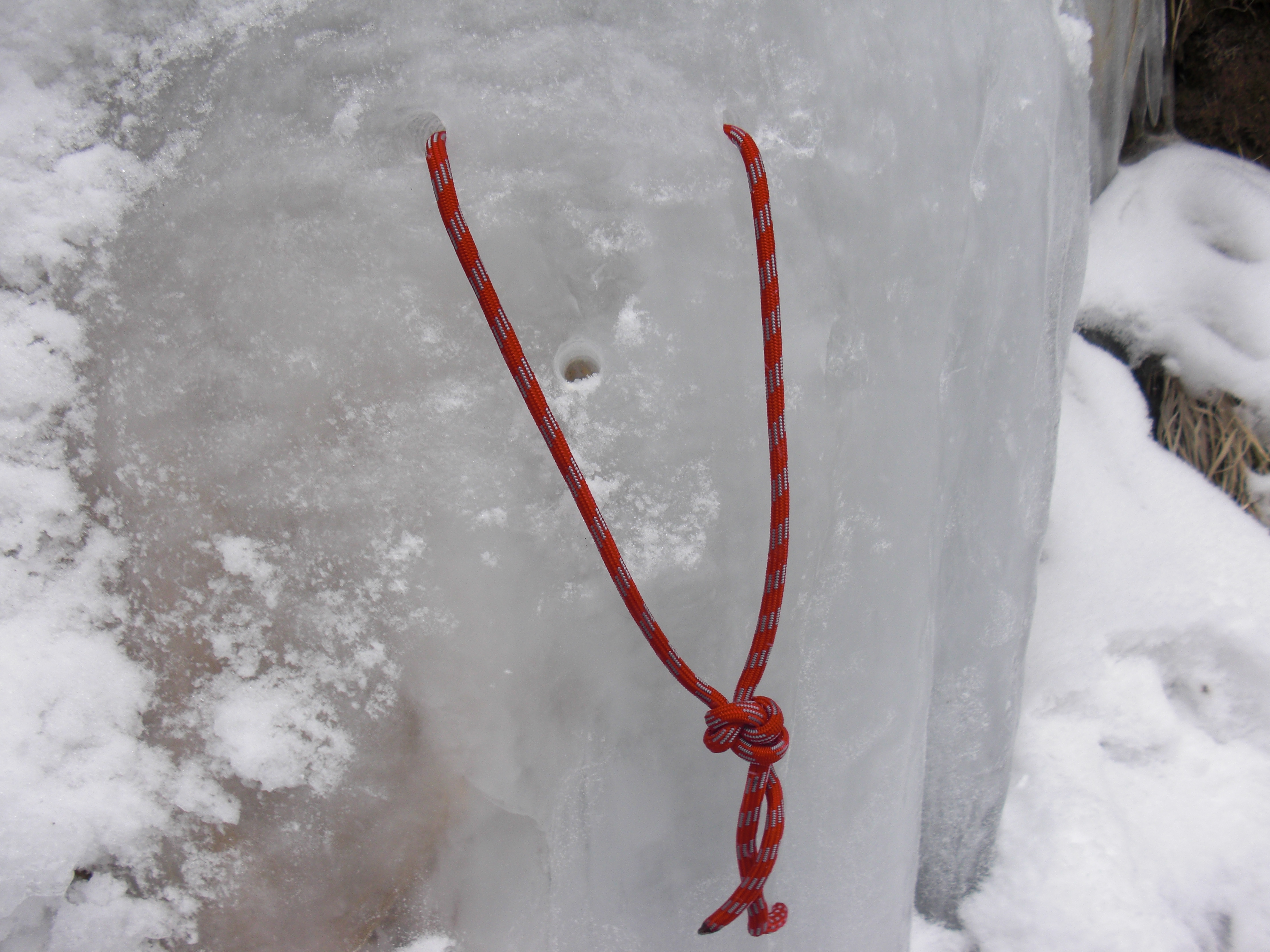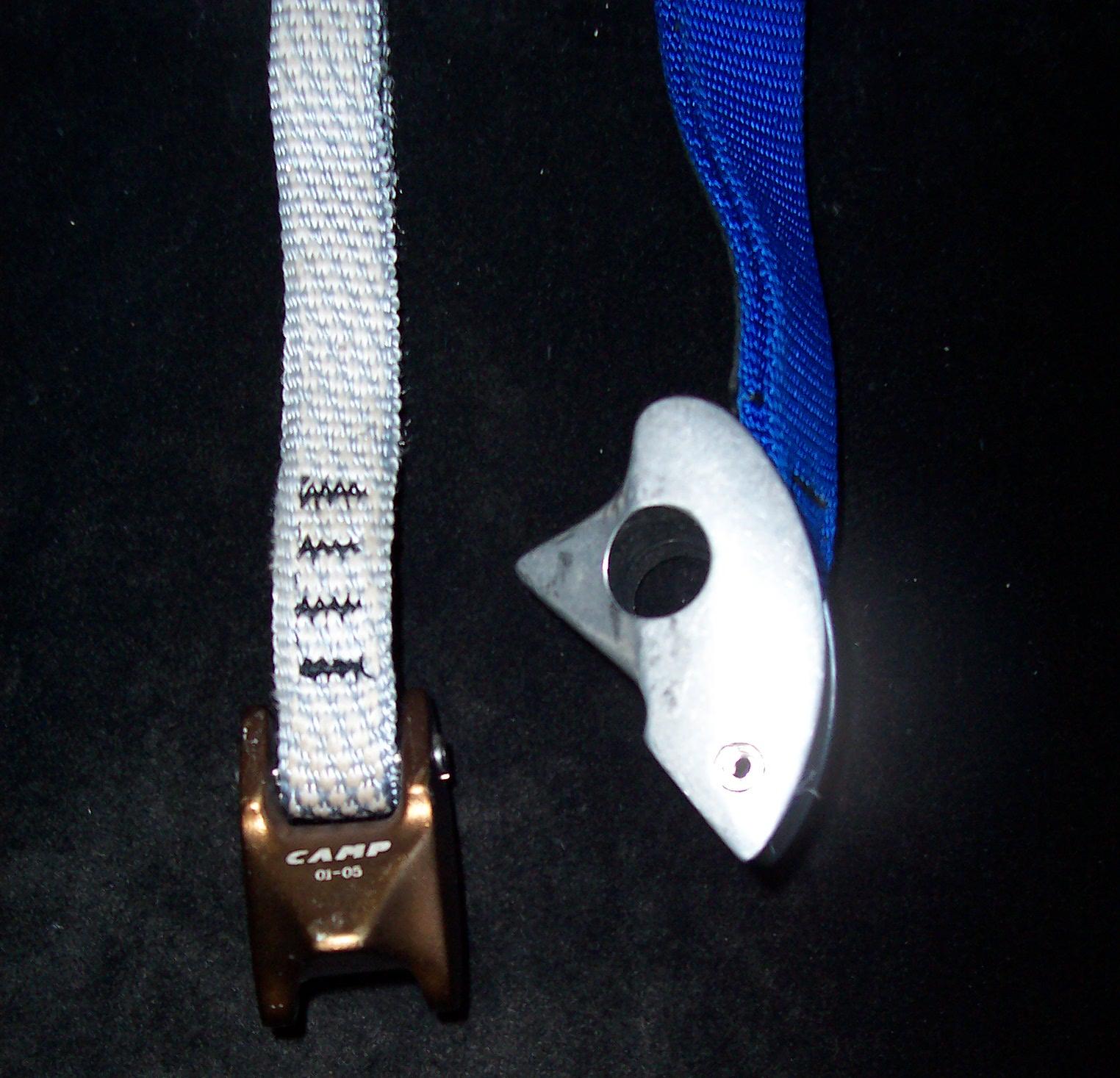|
Protection (climbing)
Climbing protection is any of a variety of devices employed to reduce risk and protect others while climbing rock and ice. It includes such items as nylon webbing and metal nuts, cams, bolts, and pitons. Different forms of climbing draw on varying forms of protection and the systems that are created from its elements. Types of climbing There are a number of ways to "protect" a climb, varying according to the type of climbing: Lead climbing A lead climber places protection (temporary or permanent anchors) in the rock, snow, or ice establishing a climbing route. The rope is clipped through carabiners (often joined by a short length of webbing into a pair known as a quickdraw) which are in turn connected to the protection. The belayer pays out rope during the ascent, and manually arrests the climber's fall by locking the rope, typically with some form of belay device. Aid climbing Aid climbing involves standing on or pulling oneself up via devices attached to fixed or p ... [...More Info...] [...Related Items...] OR: [Wikipedia] [Google] [Baidu] |
Climbing
Climbing is the activity of using one's hands, feet, or any other part of the body to ascend a steep topographical object that can range from the world's tallest mountains (e.g. the eight thousanders), to small boulders. Climbing is done for locomotion, sporting recreation, and for competition, and is also done in trades that rely on ascension; such as emergency rescue and military operations. Climbing is done indoors and outdoors and on natural (e.g. rock and ice) and artificial surfaces. Professional mountain guides or rock climbing guides (e.g. the UIAGM), were a significant element in developing the popularity of the sport in the natural environment, and remain so today. Since the 1980s, the development of competition climbing and the availability of artificial climbing walls have dramatically increased the popularity of rock climbing as a sport and led to the emergence of professional rock climbers, such as Wolfgang Güllich, Chris Sharma, Lynn Hill and Catherine ... [...More Info...] [...Related Items...] OR: [Wikipedia] [Google] [Baidu] |
Sling (climbing Equipment)
A sling or runner is an item of climbing equipment consisting of a tied or sewn loop of webbing. These can be wrapped around sections of rock, hitched to other pieces of equipment, or tied directly to a tensioned line using a Prusik style knot. They may be used as anchors, to extend an anchor to reduce rope drag, in anchor equalization, or to climb a rope. Types Slings come both sewn to length and assembled from loose webbing knotted as desired. Common sewn lengths include , , , and . They are available in widths of . Webbing for slings, also known as ''tape'', is sold off the reel, cut to length with a hot knife to prevent fraying, and tied as desired with a water knot. Sewn slings have a rated breaking strength of at least . Short sewn slings are a component of quickdraws, sometimes known as ''dogbones''. Traditionally, slings have been made of nylon. Increasingly, ultra high molecular weight polyethylene sold under the brand names Dyneema, Dynex and Spectra is used. ... [...More Info...] [...Related Items...] OR: [Wikipedia] [Google] [Baidu] |
Underwriters Laboratories
The UL enterprise is a global safety science company headquartered in Northbrook, Illinois, composed of three organizations, UL Research Institutes, UL Standards & Engagement and UL Solutions. Established in 1894, the UL enterprise was founded as the Underwriters' Electrical Bureau (a bureau of the National Board of Fire Underwriters), and was known throughout the 20th century as Underwriters Laboratories. On January 1, 2012, Underwriters Laboratories became the parent company of a for-profit company in the U.S named UL LLC, a limited liability corporation, which took over the product testing and certification business. On June 26, 2022, the companies rebranded into three distinct organizations that make up the UL enterprise. UL Solutions partners with customers and stakeholders in more than 100 countries to help solve safety, security and sustainability challenges and is also responsible for managing and issuing the highly respected portfolio of UL Marks. The company is one of ... [...More Info...] [...Related Items...] OR: [Wikipedia] [Google] [Baidu] |
European Committee For Standardization
The European Committee for Standardization (CEN, french: Comité Européen de Normalisation) is a public standards organization whose mission is to foster the economy of the European Single Market and the wider European continent in global trading, the welfare of European citizens and the environment by providing an efficient infrastructure to interested parties for the development, maintenance and distribution of coherent sets of standards and specifications. The CEN was founded in 1961. Its thirty-four national members work together to develop European Standards (ENs) in various sectors to build a European internal market for goods and services and to position Europe in the global economy. CEN is officially recognized as a European standards body by the European Union, European Free Trade Association and the United Kingdom; the other official European standards bodies are the European Committee for Electrotechnical Standardization (CENELEC) and the European Telecommunicati ... [...More Info...] [...Related Items...] OR: [Wikipedia] [Google] [Baidu] |
Union Internationale Des Associations D'Alpinisme
The International Climbing and Mountaineering Federation, commonly known by its French name Union Internationale des Associations d'Alpinisme (UIAA, lit. ''International Union of Alpine Clubs''), was founded in August 1932 in Chamonix, France when 20 mountaineering associations met for an alpine congress. Count Charles Egmond d’Arcis, from Switzerland, was chosen as the first president and it was decided by the founding members that the UIAA would be an international federation which would be in charge of the "study and solution of all problems regarding mountaineering". The UIAA Safety Label was created in 1960 and was internationally approved in 1965 and currently (2015) has a global presence on five continents with 86 member associations in 62 countries representing over 3 million people. After the 2022 Russian invasion of Ukraine, the UIAA suspended all UIAA officials from Russia, and delegates from the Russian Mountaineering Federation (RMF) and Russian officials and at ... [...More Info...] [...Related Items...] OR: [Wikipedia] [Google] [Baidu] |
Free Climbing
Free climbing is a form of rock climbing in which the climber may use climbing equipment such as ropes and other means of climbing protection, but only to protect against injury during falls and not to assist vertical or horizontal progress. The climber ascends or traverses by using physical ability to move over the rock via handholds, footholds, and body smears. The term ''free climbing'' is used in contrast to aid climbing, in which specific aid climbing equipment (such as mechanical ascenders) is used to assist the climber in ascent. The term ''free climbing'' originally meant "free from direct aid". Free climbing more specifically may include: * traditional climbing * sport climbing * bouldering * solo climbing (excluding solo aid climbing) Common misunderstandings of the term While clear in its contrast to aid climbing, the term ''free climbing'' is nonetheless prone to misunderstanding and misuse. The three most common errors are: * Confusing ''free climbing'' ... [...More Info...] [...Related Items...] OR: [Wikipedia] [Google] [Baidu] |
Skyhook (climbing)
__NOTOC__ This glossary of climbing terms is a list of definitions of terms and jargon related to rock climbing and mountaineering. The specific terms used can vary considerably between different English-speaking countries; many of the phrases described here are particular to the United States and the United Kingdom. A B Completing the climb upon one's first attempt ever. Often confused with 'flashing' which is the first attempt of the day. There is a second opportunity for a climber to 'blitz' a wall after 12 months. C D E ... [...More Info...] [...Related Items...] OR: [Wikipedia] [Google] [Baidu] |
Piton
A piton (; also called ''pin'' or ''peg'') in climbing is a metal spike (usually steel) that is driven into a crack or seam in the climbing surface using a climbing hammer, and which acts as an anchor for protecting the climber against the consequences of falling or to assist progress in aid climbing. Pitons are equipped with an eye hole or a ring to which a carabiner is attached; the carabiner can then be directly or indirectly connected to a climbing rope. Pitons were the original form of protection and are still used where there is no alternative. Repeated hammering and extraction of pitons damage the rock, and climbers who subscribe to the clean climbing ethic avoid their use as much as possible. With the popularization of clean climbing in the 1970s, pitons were largely replaced by faster and easier-to-use clean protection, such as nuts and camming devices. Pitons are still found in place (as "fixed" pitons) on some established free climbing routes, as fixed bela ... [...More Info...] [...Related Items...] OR: [Wikipedia] [Google] [Baidu] |
Aid Climbing
Aid climbing is a style of climbing in which standing on or pulling oneself up via devices attached to fixed or placed protection is used to make upward progress. The term contrasts with free climbing in which progress is made without using artificial aids: a free climber ascends by only holding onto and stepping on natural features of the rock, using rope and equipment merely to catch them in case of fall and provide belay. In general, aid techniques are reserved for pitches where free climbing is difficult to impossible, and extremely steep and long routes demanding great endurance and both physical and mental stamina. While aid climbing places less emphasis on athletic fitness and raw strength than free climbing, the physical demands of hard aid climbing should not be underestimated. In early versions of the Yosemite Decimal System, aid climbing was class 6, but today the YDS uses only classes 1-5. Aid climbing has its own ranking system, using a separate scale from A0 thro ... [...More Info...] [...Related Items...] OR: [Wikipedia] [Google] [Baidu] |
Tricam
A tricam is a type of climbing protection equipment. A versatile nut/cam hybrid, the Tricam was invented by Greg Lowe in 1973, and came to market in 1981. They are currently manufactured by C.A.M.P. of Premana Italy. Design The Tricam is a passive camming device consisting of a carefully shaped aluminium-alloy cam attached to a length of webbing tape. Most sizes are produced as a solid forged unit, but the larger sizes are made from riveted sheet metal. The device is inserted into a crack so that pulling on the tape makes the piece cam outward against the sides of the crack, gripping the rock tighter. Camming action is achieved by the position of the pointed fulcrum or pivot of the cam relative to the attachment of the tape. As the webbing is pulled, the downward force is pivoted onto the point, which can bite into soft rock or ice and increases the holding power of the tricam. [...More Info...] [...Related Items...] OR: [Wikipedia] [Google] [Baidu] |
Climbing Harness
A climbing harness is a device which allows a climber access to the safety of a rope. It is used in rock and ice climbing, abseiling, and lowering; this is in contrast to other activities requiring ropes for access or safety such as industrial rope work (such as window cleaning), construction, and rescue and recovery, which use safety harnesses instead. Overview While an improvised harness can be created out of length of rope or nylon webbing, commercially produced harnesses specific to climbing rock and ice are the norm. These characteristically include a dedicated tie-in loop, padding, and amenities such as gear loops. Most commercial climbing harnesses meet the guidelines and manufacturing standards of organizations such as the Union Internationale des Associations d'Alpinisme (UiAA) or European Committee for Standardization. Harnesses of users involved in climbing should be attached to dynamic (kernmantle) rope, which has natural shock-absorbing stretch. In via ferrata, the ... [...More Info...] [...Related Items...] OR: [Wikipedia] [Google] [Baidu] |







